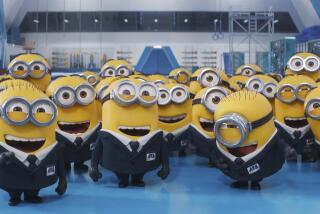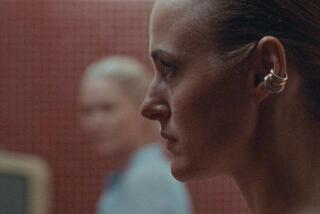Morphin Mania: How--and Why? : Television: Even the super-heroes’ creators are surprised at the popularity of the karate-chopping Power Rangers. That success raises some concerns about the characters’ message.
- Share via
For those under five feet, they’re bigger than Kerrigan and Harding, more popular than Madonna or Seinfeld. If kids ran newspapers, they’d get more ink than President Clinton, Michael Jackson and Lorena Bobbitt put together.
They’re the Mighty Morphin Power Rangers--TV super-heroes whose appearance last Monday at Universal Studios created an 8-mile traffic jam on the Hollywood Freeway. Some 35,000 preteens and their parents turned out to watch a performance by the karate-chopping band of high schoolers in brightly colored spandex suits.
Millions more tune in each day to watch episodes of Fox’s “The Mighty Morphin Power Rangers” (airing locally on KTTV-TV Channel 11 weekdays at 5 p.m. and Saturdays at 7:30 a.m.), making it the highest-rated children’s show in the United States.
There’s no questioning their popularity. But there are questions about why a primitive-looking, live-action show that is considered unwatchable by many adults has become the latest kid craze. Questions too about whether the popularity of these super-heroes can be sustained. And more questions still from some children’s television advocates who contend that despite the show’s pro-social preachiness, the fighting at the heart of each episode is likely to encourage similarly aggressive behavior in its rabid fans.
But at least for now, nothing can stop the Power Rangers, who, like the Ninja Turtles before them, have become an entire industry unto themselves.
Power Rangers merchandise--robots, monsters and figurines of the super-heroes--created a buying frenzy that resulted in pushing and shoving in toy store aisles last Christmas. Saban Entertainment, which owns the franchise, reportedly has offers from nearly every major movie studio for a film deal, and it is pursuing plans for a theme park attraction, video games and a chain of martial arts schools. Previously aired episodes of the TV show, which only debuted last September, are already available on home video.
“I’d be lying if I said we expected it to be like this, this big. It’s incredible. It’s crazy,” said Shuki Levy, who serves as executive producer of the show along with Haim Saban, head of Saban Entertainment. “But we always knew it had appeal for children, and that’s because we have created this whole fantasy world with a somewhat primitive approach.” Margaret Loesch, president of the Fox Children’s Network, said she thought the show would catch on because it is different than cartoons and the average kid fare. The series features the teen-age karate experts--three boys and two girls--battling monsters dressed in cheesy alien costumes that have been sent to Earth by Rita Repulsa, Empress of Evil, whose segments are made in Japan and then dubbed into English like the old “Godzilla” movies.
But not even Loesch anticipated that “Power Rangers” would become as big as He-Man, the Smurfs or the Ninja Turtles.
“Kids are desperately in need of positive role models and, whether or not they like the show, people agree that our teen-age stars are delightful to both boys and girls,” Loesch said. “And it is extremely rare that an action-adventure show appeals to girls as well as boys.”
Many adults, however, take one look at this show--with the ridiculous robot fight sequences and simple live-action sitcom plots--and cringe.
“I can’t stand it. It’s so stupid,” said Dorothy G. Singer, professor of psychology and co-director of the Yale University Family Television Research and Consultation Center. “But kids like super-heroes. They like to identify with someone who is powerful. Kids are small and not in control of their own destiny, so when they identify with someone powerful, they feel strong and powerful.”
Kathryn Montgomery, president of the Center for Media Education, a nonprofit organization in Washington that monitors children’s television and tries to encourage educational shows, said that the avid marketing of the “Power Rangers” merchandise fuels the popularity of the series.
The series itself may also increase the popularity of violence, Singer and Montgomery agreed. The longest sequences in each episode tend to be fight sequences filled with karate, robotics and magic swords. The message, Singer said, “is you fight with your enemies. There’s no trying to negotiate. You just get rid of them.”
These critics of the program pointed to studies indicating that children who view a lot of action-adventure shows tend to behave more aggressively. “They become more restless and they imitate what they see,” Singer said. “They don’t always understand that it’s fictional and done with special effects and that they can’t do a karate chop or hit someone with a stick in a real-life situation.”
Levy defended the show by saying that all the fight elements are clearly marked as fantasy.
“It’s all relative. You can go back to the Bible stories and say maybe children shouldn’t hear about David slaying Goliath,” he said. “But here, we have only imaginary monsters and you see them making it out of clay in a machine. So you never feel like they have killed a real person or an animal. And in the other side of the story, you never see the Rangers fighting other people, and I think it’s easy for kids to see the difference.”
Levy added that each episode features a positive message about self-esteem or getting along with those who are different. Usually, this message is proclaimed in dialogue among the teen-age heroes at the end of the program.
Montgomery called that a mixed message. “On the one hand you have the pro-social messages--be good citizens and get along--and yet it resolves all conflict with a fight,” she said. “It’s very conflicted, and it’s almost as if these so-called action shows have incorporated pro-social moments to justify the violence.”
Loesch said she was concerned about that problem before the series debuted and insisted on creating public-service announcements for the end of every episode that bluntly explain to children that the show is fantasy and not to be imitated. Future spots will deal with peaceful methods of conflict resolution, anger management and the difference between fantasy and reality, she said.
“They may be getting subtle messages from the show, but these spots are not subtle and not confusing,” Loesch said. “They explain that the show is entertainment and what the kids should be learning are the values of the heroes and that they absolutely should not try to imitate the action.”
Can the craze--for better or worse--last?
Singer said that such fads come around every couple of years and then disappear. She expects the same for the Power Rangers. Montgomery agreed, noting that it’s in the interest of toy manufacturers to come up with something new.
“If a younger brother is crazy about the same show his older brother once liked, then he simply inherits all the old toys and you don’t have to buy new products,” Montgomery said. “So there always is going to be some new thing. It’s the nature of the beast.”
But Loesch predicts the Power Rangers will be different.
“I really don’t think that this is going to be a flash in the pan,” she said. “Children seem to like the kids in the show so much and they like the fantasy of teen-agers being endowed with special powers, that I’m really hoping it will last five or even 10 years. I think it has that potential.”
More to Read
The complete guide to home viewing
Get Screen Gab for everything about the TV shows and streaming movies everyone’s talking about.
You may occasionally receive promotional content from the Los Angeles Times.






